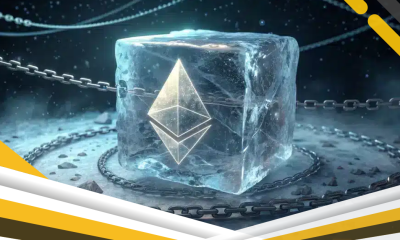Ethereum Fees Dip to $0.04: Cheaper Transactions Ahead?

The cost of transacting on the Ethereum blockchain has recently reached remarkably low levels, with gas fees dropping to as little as $0.04 for certain operations. This significant reduction comes amid a notable cooldown in overall market activity, marking a stark contrast to periods when transaction costs often soared into the double or even triple digits. The current affordability presents a fresh dynamic for users and developers navigating the world’s second-largest cryptocurrency network.
Ethereum’s network fees, often referred to as “gas fees,” plunged to an average of just 0.067 Gwei on Sunday, November 9, 2025, reflecting a considerable dip in on-chain activity following a volatile market period in October. This makes executing various transactions on the Ethereum mainnet more accessible than they have been in years.
Current State of Ethereum Transaction Costs
The recent drop in Ethereum gas fees has made a range of common blockchain activities exceptionally inexpensive. For instance, bridging digital assets to other blockchain networks can now cost approximately $0.04. On-chain borrowing is similarly affordable, averaging around $0.09.
Other popular operations also reflect this downward trend:
- Executing a token swap on Ethereum currently costs about $0.11.
- Non-fungible token (NFT) sales carry an average fee of $0.19.
These figures represent a dramatic shift from earlier periods, particularly the 2021 bull run, when transaction fees could frequently exceed $100 or even $150 during times of high network congestion. More recently, gas prices peaked at 15.9 Gwei on October 10, 2025, coinciding with a market flash crash. However, within just two days, by October 12, fees had collapsed to around 0.5 Gwei and have largely remained below 1 Gwei throughout October and November.
Factors Contributing to Lower Ethereum Gas Fees
Several key factors have converged to drive down Ethereum transaction costs:
Market Activity Cooldown
A primary driver for the current low fees is a general deceleration in the broader crypto market. Data indicates a noticeable slowdown in Ethereum’s on-chain momentum, with a decline in internal contract calls, transaction counts, and network growth. For example, the daily transaction count has seen a pullback from around 1.6 million to significantly lower figures, and new addresses joining the ecosystem have also decreased. This muted sentiment suggests investors have shifted from active accumulation to a more cautious observation phase, directly reducing demand for block space and, consequently, gas prices.
Impact of the Dencun Upgrade
Another pivotal factor is the Ethereum Dencun upgrade, implemented in March 2024. This significant network enhancement, which combined the Cancun and Deneb upgrades and introduced nine Ethereum Improvement Proposals (EIPs), was primarily designed to improve scalability and reduce transaction costs for Layer 2 (L2) networks.
The Dencun upgrade introduced “blobs” (EIP-4844), which provide dedicated, cheaper data storage space for L2 rollups. Prior to Dencun, L2s stored their transaction data on the mainnet as calldata, which was expensive. By offloading this data to blobs, the cost for L2 transactions plummeted. According to various reports, the average gas fee on Ethereum decreased by approximately 95% in the year following the Dencun upgrade, falling from around 72 Gwei in 2024 to about 2.7 Gwei by March 2025.
Implications for Ethereum’s Long-Term Sustainability
While cheaper transactions are unequivocally beneficial for end-users, the prolonged period of low fees introduces a “double-edged sword” scenario for the Ethereum network’s long-term health.
Reduced Validator Incentives
Ethereum relies on validators to secure the network and process transactions. These validators are compensated through block rewards and transaction fees. A significant and sustained drop in fee revenue, such as the 99% decline in Ethereum’s base-layer fee revenue observed since the Dencun upgrade, can reduce the incentives for validators. Analysts express concern that if fees remain excessively low, it could potentially weaken the economic model that incentivizes network participants, thereby presenting both financial and security challenges for Ethereum over time.
Layer 2 Ecosystem and Base-Layer Revenue
The success of Layer 2 scaling solutions like Arbitrum, Optimism, and Base in making transactions cheaper and faster has also, paradoxically, “cannibalized” much of the base-layer’s fee revenue. Users are increasingly opting for these L2 networks for their daily transactions, which significantly reduces the demand for direct mainnet transactions and, consequently, the fees collected by Ethereum’s Layer 1. This shift, while improving scalability and user experience across the wider ecosystem, places pressure on the revenue model of the core blockchain itself.
Frequently Asked Questions (FAQ)
What are Ethereum gas fees?
Ethereum gas fees are the cost associated with performing an operation or executing a transaction on the Ethereum blockchain. They are paid in Ether (ETH), Ethereum’s native cryptocurrency, and compensate validators for the computational effort and resources required to process and secure transactions on the network. The “gas price” is measured in Gwei, where 1 Gwei equals 0.000000001 ETH.
How does the Dencun upgrade affect gas fees?
The Dencun upgrade primarily reduced gas fees for Layer 2 (L2) scaling solutions by introducing “blobs” (EIP-4844). These blobs provide a cheaper way for L2s to store transaction data on the Ethereum mainnet. While it didn’t directly reduce mainnet fees for all transactions, by making L2s significantly cheaper, it drew a substantial amount of transaction volume away from the mainnet, indirectly contributing to lower overall mainnet congestion and fees.
Why is a “market activity cooldown” important for gas fees?
Ethereum’s gas fees operate on a supply and demand model. When network activity is high (many users are trying to make transactions), demand for block space increases, leading to higher gas prices. Conversely, during a market activity cooldown, fewer users are making transactions, reducing congestion and lowering the demand for block space, which results in cheaper gas fees.
Conclusion
The current period of exceptionally low Ethereum transaction fees, with costs as minimal as $0.04, offers a welcome reprieve for users and a significant boost to accessibility for decentralized applications. This affordability is a confluence of a broader crypto market cooldown and the architectural improvements brought by the Dencun upgrade, which supercharged Layer 2 scalability. While users are enjoying the benefits of near-free transactions, the long-term implications for Ethereum’s base-layer revenue and validator incentives remain a topic of careful consideration within the ecosystem. The balance between fostering a vibrant Layer 2 ecosystem and ensuring the sustainable economic security of the Layer 1 network will continue to be a critical challenge as Ethereum evolves.












